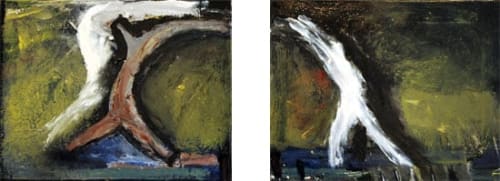“It’s all a mystery, you’re in it, you have to discover it, give it reason…"
Alan Pearson, New Zealand Cultural Icons documentary 28 & 29, 2010
Mercurial in nature, Alan Pearson had an ability to switch from expressionist representation to abstraction while revealing the underlying spirit and psyche in a person or place. When discovering a new location and needing to understand and establish the resident form, colour and light, he would use the old academic methods; landscape, still life, life drawing and portraiture. That method formed the basis of any artistic narrative he subsequently chose to articulate. Works in this exhibition span forty-six years of his art practice and express, in visual imagery, his search to give reason to life and the land in which we live.
A self-portrait painted in Auckland in 1967 is the earliest work in this show. The portrait is dominated by ultramarine blue, sap green, and cadmium yellow. The Fauvist use of colour illustrates the artist’s introspective mood, and the elemental nature of Auckland. It is an essay in tonality and the expressive merging of body and soul through colour.
A life-long love of music and dance enhanced Alan’s understanding of flowing forms whether in the figurative drawings Jennifer and When the spirit calls or music that he saw in the landscape at Huia, at the head of the Manukau harbour. That was the site for the double portrait, Huia Couple, Leo and Linda in the Christchurch Art Gallery collection. Spending time painting in situ in the forest Alan observed, and came to love, the clouds scudding through the sky and the wind billowing through the trees.
In Huia Variations, Ti-tree chorus light in the vortex is filled with manuka (Ti-trees) flowing left to right. In both Ti-tree chorus and …Huia, Pink ladies Alan sought a smooth surface that would make the paint flow to create chorus-lines. Wah Lee’s shop in Hobson Street provided the calligraphy brushes and the red-lipped ‘pink ladies’ were locally inspired by a bakery in Herne Bay that Alan passed on his morning walk. Wherever the eye wanders in these paintings there is animated colour and music: dissonance and harmony.
These Auckland paintings are west coast works as are Symphonic study, 10 Mile and West Coast presences both painted when Alan was artist in residence at the Tai Poutini Polytech in Greymouth. He had already been wandering the South Island’s West Coast when the opportunity arose for him to base himself there for a few months. Sea, land and mining, both coal and gold, infiltrated his senses along with isolation and the hardy people who inhabit that landscape. Up in the hills, following a track to a coal mine Alan painted the lushness of the dense, bush-clad hills.
In Symphonic study, 10 Mile the painterly, plastic, sensuous pigments, with accents of golden brushstrokes, create a sense of time indicative of both antiquity and the real gold hidden beneath the fertile, forest canopy. In the West Coast presences diptych the density of colour and mixing of tones lends an aura of history, of mining and the movement of people through the land, around the hills and across the sea. By making the figurative shapes abstract they move into the realm of spirits or presences as in the title.
In contrast to the abundance of sap green in the southern West Coast paintings Bush fantasy was painted during a period of drought best described by the opening lines of a poem Alan wrote about this work: “Bush fantasy, musical whimsy/ Dry is the ground/ dry is the air/ movement is needed to stir/ to vent moribund mass/ for its place in Time.” Throughout Alan’s Bush symphony series, the musicality of nature is translated into a dance in paint, a musical rendition in the visual medium. Figures inscribed by calligraphic shapes shift across the canvas in ever moving forms while vertical lines tether the imagery to the landscape within the picture plane. Intensely energetic with warm hues creating an optimistic feeling they are reflective of Alan himself, vivid, witty and wise.
The ease with which he could paint or draw a figure or a head is evident in the Six Males Portrait series, two drawings of which are in this show. Rather than render a particularly physical representation Alan always focused on the expression of the inner life, the sitter’s psyche, with the intended outcome unknown until the drawing was finished. He mapped a person’s psychology and emotion as a result of the long studies of himself, he knew where the cracks and fissures lay after interacting with his sitters. His method involved conversation, music and song and was intentionally individual as he gained understanding of the person. And technically his fluidity with the pencil or charcoal or paint enabled him to draw and capture spontaneity. Humour and mischief (personal traits) enlivened both paintings and in drawings such as in Hello, with its cheeky sideways glance, and the flat perspective in I love you, they are the cartoon outcome of analyzing hundreds of psyches throughout his artistic career.
Alison Pearson April 2021
